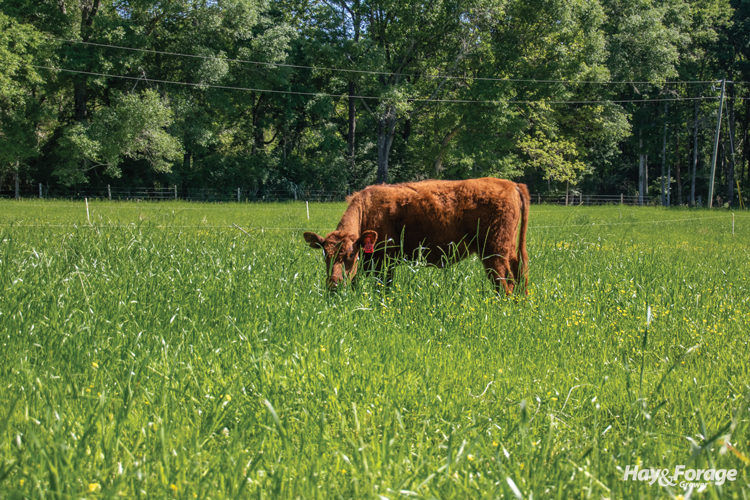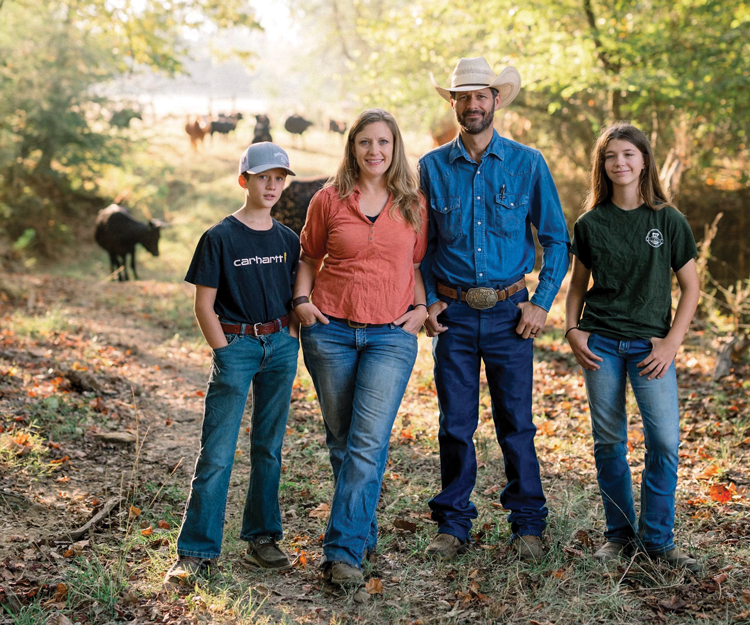
Sometimes an opportunity presents itself that is too good to pass up. In Tara and Josh Morris’ case, it was a series of several opportunities strung together that made their dreams of grazing cattle in southern Louisiana a reality.
Tara and Josh both got their feet wet in agriculture by working on research farms in college before they rented their first piece of land in 2016. They leased the then conventionally farmed field from a friend under the condition that they fix the fence. Once that was complete, the purchase of one cow led to another until they were running 35 cows, calves, and finishing cattle on 52 acres.
The couple resolved to rotate their cattle through smaller paddocks out of necessity, but it was this shift in management that opened their eyes to regenerative grazing. After four years, they transformed the low-quality field into a lush pasture anchored in soil that was noticeably healthier than when they started. Since then, they have rented several other properties with the same motivation to leave the land better than when they found it.
“We began completely focused on cattle with only a little thought about grass,” Tara said. “I think we started backwards but are flipping our mindset to focus on soil first, then grass, then lastly, the grazing animals.”
The Morrises currently run cattle on three leases within 15 miles of each other just north of Baton Rouge that Tara, Josh, and his father manage separately to divide and conquer daily chores. Their children, June and Ruben, also help make pasture moves and market meat for the family’s beef business, and it is with sage advice from other farmers, a network of neighbor graziers, resourceful reading material, and the occasional YouTube video that the family continues to make their operation more sustainable and efficient.
Based in bahiagrass
On a sunny Saturday morning in mid-April, Tara assessed the forage in the “ugly” pasture at the home farm near the town of Slaughter. The sacrifice paddock was established the previous year to avoid overgrazing during the historic drought that seriously compromised plant growth in the Deep South. Despite an abundance of buttercup on display, the ugly pasture was well on its way to recovery thanks to some recent rain.
The yellow flowers of the annual weed were few and far between in front of the farmhouse. Instead, it was prime time for ryegrass growth in the pasture that was divided into paddocks for a small herd of weaned calves. Bahiagrass was also starting to pop up.
“Bahiagrass loves Louisiana,” Tara chuckled, pointing out the perennial forage. Even so, she purported not all Louisiana farmers love it back.
“I don’t think people appreciate it as well as they could,” she continued. “Bahiagrass is a staple here. If you keep it in a vegetative state by grazing it well, we have found you can beat the summer slump.”
To do this, the Morrises rotate their cattle to new bahiagrass paddocks nearly every day. The perennial pastures are also complemented by ball clover in the spring, which readily reseeds itself and thrives in the wetter soils.
By August, they start to stockpile about half of the acres at each leased site and let cattle graze the rest of the forage hard ahead of planting ryegrass, wheat, and oats in mid-October. Then they seed the cool-season species with a Plant-O-Vator drill, which Tara said is a rare piece of equipment that she acquired in a lucky deal.
Cattle graze stockpiled bahiagrass into the winter until the Morrises start to buy and feed hay. December and January are the toughest months to manage animals before they can begin grazing ryegrass, oats, and wheat in the spring, and it’s a time of year the couple must keep in mind when making stocking decisions for each herd.
“We figured out that we need a stocking rate for what we can handle when cattle are on the stockpile and hay,” Tara asserted. “The stockpile is only half of our land that is available because the other half is planted and waiting to grow.”
Ryegrass production typically ramps up during the tail-end of February when the weather takes a turn for the better, and the Morrises put cattle out on the annual forage in March. Tara reckons cows make most of their gains on the annual ryegrass from March through May and then maintain body condition by grazing bahiagrass when it resumes growing. This year, the couple also planted a mix of sorghum-sudangrass, sunn hemp, pearl millet, buckwheat, and cowpeas in small plots to boost forage supplies and animal gains through the summer and fall.
A shock to the system
Planning pasture moves and planting dates are recurring considerations for the couple, but having flexibility with temporary fencing offers some elbow room in their grazing schedule. Using polywire wasn’t a skill that came naturally to them, though. In fact, dividing pastures and stocking paddocks was the biggest challenge the Morrises faced when they started farming.
“We would come out every day and the polywire would just be drug through the pasture by the untrained calves,” Tara recounted. “We would set it back up only for it to happen again the next day. We wanted to give up rotational grazing; we wanted to quit.”
The problem, they discovered, was that their voltage was too low. With feedback from an area fencing expert and more knowledge on best practices, the couple resolved to train cows to a single line of polywire charged to a higher voltage, which keeps cows contained to the paddock yet allows calves to roam. The latter was simply a matter of picking their battles.
Another battle to pick — or not pick — was weed control. Leveraging their limited working capital for expensive inputs wasn’t in the Morrises’ budget. Luckily, intensive grazing and quick rotations have allowed for denser forage that suppresses most weeds without herbicide or mechanical control.
Insight from other graziers inspired a shift in perspective on weeds as well. Tara and Josh have come to embrace less desirable species as integral parts of the entire system by understanding how weeds communicate changes in growing conditions, soil moisture, and soil fertility. She also believes in animals’ intuition to graze weeds that might provide some extra nutrition and trusts their instincts to avoid harmful ones.
“We’ve learned to worry a lot less about weeds,” Tara shrugged. “We believe that all things have a purpose.”

Three Twelve Beef
Despite the difficulty of moving cattle through the spring flush fast enough, this rapid growth curve aligns nicely with the Morrises’ grass-fed beef sales. They have about 120 cows and retain steers and heifers between the fall and spring calving seasons to sustain their farm-to-table business, Three Twelve Beef.
“In April, cattle start to gain weight again and we can finally finish them out,” Tara said. “April through November is the best time for us to market beef because that’s when we can best keep the cattle growing.”
Tweaking herd genetics to enhance this growth has been an ongoing experiment. The herd originally was comprised of Angus cows, but the couple is slowly adding animals with Corriente, Red Devon, Murray Gray, and South Poll influence. They also started raising their own bulls to target specific traits for better meat quality and grazing performance. Red Devon and South Poll sires have become a mainstay in their breeding program, especially for the sake of their superior heat tolerance, which is essential to beat the high temperatures and even higher humidity that can suffocate the Bayou State.
“We select animals that thrive efficiently in our system, not just based on breeds or pedigrees,” Tara stated.
It takes roughly two years for an animal to finish out, but the Morrises acquire cull cows and heifers from a nearby cow-calf farmer to market as well. They process about one animal per week to keep up with their direct-to-consumer sales, which are carried out at farmers markets, via delivery, and at a local pick-up point.
Most customers are repeat buyers who want beef to fill their freezers and feed their families. Tara relies on four part-time employees to manage sales, drop off boxes, and run a Three Twelve Beef booth at farmers markets. One of the key aspects of their business, though, is education. Properly preparing grass-fed beef varies from cooking grain-fed beef, and Tara wants her customers to ease into the best eating experience.
“If you haven’t had grass-fed beef before, start with ground beef or roast. If you like that, I can show you how to cook a steak,” she smiled.
Rooted in community
In addition to educating her customers, Tara also gives guidance to fellow farmers as an education and outreach coordinator with the Louisiana Grazing Lands Conservation Initiative (LGLCI). The organization facilitates networking opportunities and training programs for landowners focused on sustainable agriculture.
On that same Saturday in mid-April, after checking the herd and rotating cattle to fresh grass, Tara drove five miles down the road to represent LGLCI at a pasture walk hosted by a neighbor. The group included beef and sheep graziers of all ages who gathered under a canopy tent for lunch after the tour. Introductions were made and ideas were exchanged over hearty servings of jambalaya doused in hot sauce and ice-cold cups of sweet tea.
It is connections like these between beginning farmers and veteran graziers that Tara is eager to facilitate through her work, though she is just as grateful to be a part of the community herself. She attributes the growth of Three Twelve Beef to the insight and wisdom received from forage specialists, beef producers, and fencing experts who have led the way for her family; however, the cattle company would not be what it is without the Morrises’ emphasis on regenerative agriculture and deep-seeded passion to farm.
This article appeared in the August/September 2024 issue of Hay & Forage Grower on pages 20-21.
Not a subscriber?Click to get the print magazine.

